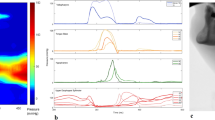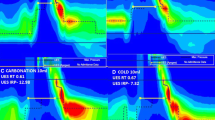Abstract
The reasons for aspiration in healthy adults remain unknown. Given that the pharyngeal phase of swallowing is a key component of the safe swallow, it was hypothesized that healthy older adults who aspirate are likely to generate less pharyngeal peak pressures when swallowing. Accordingly, pharyngeal and upper esophageal sphincter pressures were examined as a function of aspiration status (i.e., nonaspirator vs. aspirator), sensor location (upper vs. lower pharynx), liquid type (i.e., water vs. milk), and volume (i.e., 5 vs. 10 ml) in healthy older adults. Manometric measurements were acquired with a 2.1-mm catheter during flexible endoscopic evaluation. Participants (N = 19, mean age = 79.2 years) contributed 28 swallows; during 8 swallows, simultaneous manometric measurements of upper and lower pharyngeal and upper esophageal pressures were obtained. Pharyngeal manometric peak pressure was significantly less for aspirators (mean = 82, SD = 31 mmHg) than for nonaspirators (mean = 112, SD = 20 mmHg), and upper pharyngeal pressures (mean = 85, SD = 32 mmHg) generated less pressure than lower pharyngeal pressures (mean = 116, SD = 38 mmHg). Manometric measurements vary with respect to aspiration status and sensor location. Lower pharyngeal pressures in healthy older adults may predispose them to aspiration.


Similar content being viewed by others
References
Witte U, Huckabee ML, Doeltgen SH, Gumbley F, Robb M. The effect of effortful swallow on pharyngeal manometric measurements during saliva and water swallowing in healthy participants. Arch Phys Med Rehabil. 2008;89(5):822–8.
Castell JA, Dalton CB, Castell DO. Pharyngeal and upper esophageal sphincter manometry in humans. Am J Physiol. 1990;258(2 Pt 1):G173–8.
Perlman AL, Schultz JG, VanDaele DJ. Effects of age, gender, bolus volume, and bolus viscosity on oropharyngeal pressure during swallowing. J Appl Physiol. 1993;75(1):33–7.
Dodds WJ, Hogan WJ, Lydon SB, Stewart ET, Stef JJ, Arndorfer RC. Quantitation of pharyngeal motor function in normal human subjects. J Appl Physiol. 1975;39(4):692–6.
Cerenko D, McConnel FM, Jackson RT. Quantitative assessment of pharyngeal bolus driving forces. Otolaryngol Head Neck Surg. 1989;100(1):57–63.
Dantas RO, Kern MK, Massey BT, Dodds WJ, Kahrilas PJ, Brasseur JG, Cook IJ, Lang IM. Effect of swallowed bolus variables on oral and pharyngeal phases of swallowing. Am J Physiol. 1990;258(5 Pt 1):G675–81.
Butler SG, Stuart A, Castell D, Russell GB, Koch K, Kemp S. Effects of age, gender, bolus condition, viscosity, and volume on pharyngeal and upper esophageal sphincter pressure and temporal measurements during swallowing. J Speech Lang Hear Res. 2009;52(1):240–53.
Gumbley F, Huckabee ML, Doeltgen SH, Witte U, Moran C. Effects of bolus volume on pharyngeal contact pressure during normal swallowing. Dysphagia. 2008;23(3):280–5.
Kahrilas PJ, Logemann JA, Lin S, Ergun GA. Pharyngeal clearance during swallowing: a combined manometric and videofluoroscopic study. Gastroenterology. 1992;103(1):128–36.
Ghosh SK, Pandolfino JE, Zhang Q, Jarosz A, Kahrilas PJ. Deglutitive upper esophageal sphincter relaxation: a study of 75 volunteer subjects using solid-state high-resolution manometry. Am J Physiol Gastrointest Liver Physiol. 2006;291(3):G525–31.
Cook IJ, Dodds WJ, Dantas RO, Massey B, Kern MK, Lang IM, Brasseur JG, Hogan WJ. Opening mechanisms of the human upper esophageal sphincter. Am J Physiol. 1989;257(5 Pt 1):G748–59.
Jacob P, Kahrilas PJ, Logemann JA, Shah V, Ha T. Upper esophageal sphincter opening and modulation during swallowing. Gastroenterology. 1989;97(6):1469–78.
Kern M, Bardan E, Arndorfer R, Hofmann C, Ren J, Shaker R. Comparison of upper esophageal sphincter opening in healthy asymptomatic young and elderly volunteers. Ann Otol Rhinol Laryngol. 1999;108(10):982–9.
Olsson R, Nilsson H, Ekberg O. Simultaneous videoradiography and pharyngeal solid state manometry (videomanometry) in 25 nondysphagic volunteers. Dysphagia. 1995;10(1):36–41.
Huckabee ML, Butler SG, Barclay M, Jit S. Submental surface electromyographic measurement and pharyngeal pressures during normal and effortful swallowing. Arch Phys Med Rehabil. 2005;86(11):2144–9.
Butler SG, Stuart A, Kemp S. Flexible endoscopic evaluation of swallowing in healthy young and older adults. Ann Otol Rhinol Laryngol. 2009;118(2):99–106.
Butler SG, Stuart A, Markley L, Rees C. Penetration and aspiration in healthy older adults as assessed during endoscopic evaluation of swallowing. Ann Otol Rhinol Laryngol. 2009;118(3):190–8.
Belafsky PC, Postma GN. Validity and reliability of the reflux symptom index (RSI). J Voice. 2002;16(2):274–7.
Salassa JR, DeVault KR, McConnel FM. Proposed catheter standards for pharyngeal manofluorography (videomanometry). Dysphagia. 1998;13:105–10.
Hiss SG, Huckabee ML. Timing of pharyngeal and upper esophageal sphincter pressures as a function of normal and effortful swallowing in young healthy adults. Dysphagia. 2005;20(2):149–56.
Castell JA, Castell DO. Recent developments in the manometric assessment of upper esophageal sphincter function and dysfunction. Dig Dis. 1997;15(Suppl 1):28–39.
Rosenbek JC, Robbins JA, Roecker EB, Coyle JL, Wood JL. A penetration-aspiration scale. Dysphagia. 1996;11(2):93–8.
Keppel G, Wickens TD. Design and analysis: a researcher’s handbook. 4th ed. Englewood Cliffs, NJ: Prentice Hall; 2004.
Cohen J. Statistical power analysis for the behavioral sciences. 2nd ed. Hillsdale, NJ: Lawrence Erlbaum Associates; 1989.
Fries JF. Aging, natural death, and the compression of morbidity. N Engl J Med. 1980;303(3):130–5.
Rantanen T, Harris T, Leveille SG, Visser M, Foley D, Masaki K, Guralinik JM. Muscle strength and body mass index as long-term predictors of mortality in initially healthy men. J Gerontol A Biol Sci Med Sci. 2000;55:M168–73.
Crow HC, Ship JA. Tongue strength and endurance in different aged individuals. J Gerontol A Biol Sci Med Sci. 1996;51(5):M247–50.
Nicosia MA, Hind JA, Roecker EB, Carnes M, Doyle J, Dengel GA, Robbins J. Age effects on the temporal evolution of isometric and swallowing pressure. J Gerontol A Biol Sci Med Sci. 2000;55(11):M634–40.
Stierwalt JA, Youmans SR. Tongue measures in individuals with normal and impaired swallowing. Am J Speech Lang Pathol. 2007;16(2):148–56.
Robbins J, Levine R, Wood J, Roecker EB, Luschei E. Age effects on lingual pressure generation as a risk factor for dysphagia. J Gerontol A Biol Sci Med Sci. 1995;50(5):M257–62.
Youmans SR, Stierwalt JA. Measures of tongue function related to normal swallowing. Dysphagia. 2006;21(2):102–11.
Youmans SR, Youmans GL, Stierwalt JA. Differences in tongue strength across age and gender: is there a diminished strength reserve? Dysphagia. 2009;24(1):57–65.
Acknowledgments
This work was supported by a new investigators research grant from the American Speech Language Hearing Foundation and in part by the Wake Forest School of Medicine Claude D. Pepper Older Americans Independence Center (P30 AG21332). We thank Karen Potvin Klein, MA, ELS (Research Support Core, Wake Forest University Health Sciences) for her editorial contributions to the manuscript.
Author information
Authors and Affiliations
Corresponding author
Rights and permissions
About this article
Cite this article
Butler, S.G., Stuart, A., Wilhelm, E. et al. The Effects of Aspiration Status, Liquid Type, and Bolus Volume on Pharyngeal Peak Pressure in Healthy Older Adults. Dysphagia 26, 225–231 (2011). https://doi.org/10.1007/s00455-010-9290-4
Received:
Accepted:
Published:
Issue Date:
DOI: https://doi.org/10.1007/s00455-010-9290-4




